 | The Nitrous Files
| The Nitrous Files
Nitrous oxide experimentation is a sort of rite of passage when concerning the high-performance greenhorn. End results may vary, but they almost always end up one of two ways, both of which can be viewed as encouraging given the proper perspective. There's no disputing that nitrous oxide makes slow cars quick. However, it can also afford those looking to understand the inner workings of the internal combustion short-block the advanced opportunity by means of a retrofitted peephole courtesy of lean air/fuel mixtures and excessive cylinder pressures. Call it a win-win.
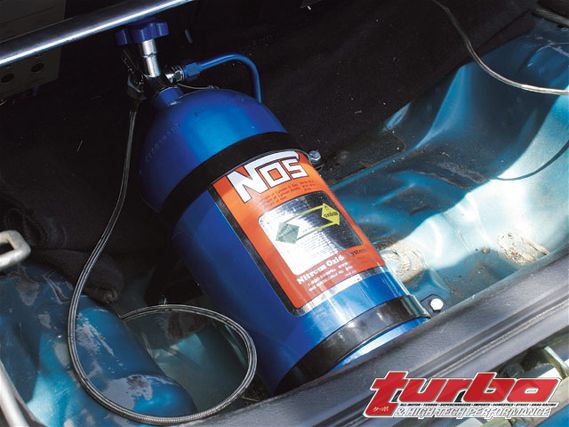 | The Nitrous Files
| The Nitrous Files
Last month we saw what happens when nitrous oxide and turbos pair up, but nitrous oxide as a stand-alone method of forced induction is arguably more popular albeit just as volatile. Entry-level enthusiasts are often attracted to this gaseous combination because of its reasonably modest entry cost and simple installation process. Unfortunately, somewhere along the line, nitrous oxide and engines with connecting rods poking out the backside have become synonymous with one another. Things don't have to be this way though, cylinder pressure is cylinder pressure, whether you're talking about turbochargers, superchargers or nitrous oxide; it's all about setup and proper tuning.
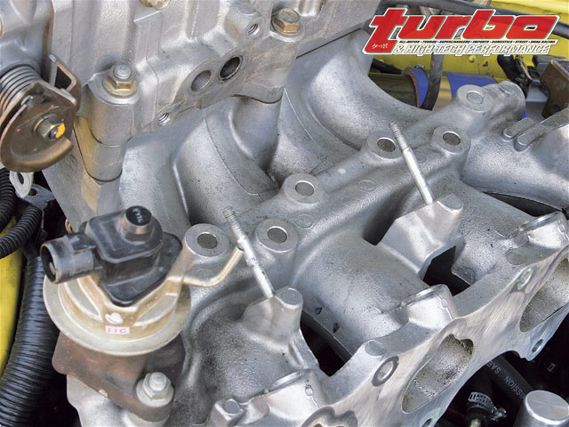 | The H22A's exhaust gas recirculation system makes nitrous fogger installation next to impossible since it's integrated onto the top of the manifold.
| The H22A's exhaust gas recirculation system makes nitrous fogger installation next to impossible since it's integrated onto the top of the manifold.
Venovus Engineering is attempting to simplify the nitrous oxide process and make it safer and more reliable. There are a few shortcomings when it comes to the conventional nitrous oxide system. Throttle activation brackets are often make shift, can bend or move, and can sometimes make delivery less than reliable. Nitrous and fuel relays as well as activation switches can also complicate the installation process and add to the number of potential problems, oftentimes user-created, but problems are problems. Ever seen the after effects of an engine cranked over with a nitrous system that's been left activated? It isn't heartwarming, to say the least. Venovus' approach to nitrous simplification and safety is two-pronged and consists of their NCM-2 Nitrous Control Module and VRM-1 Nitrous Solenoid Driver.
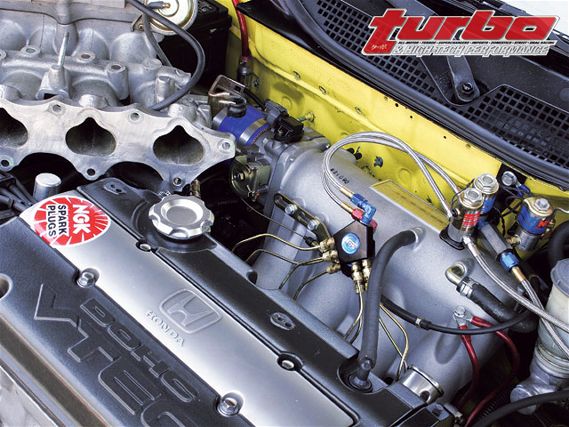 | The Skunk2 Pro Series intake manifold has a significantly larger plenum and fatter runners, which contributed to some impressive midrange torque and horsepower gains. To get there, we had our Hondata S100 fine-tuned at Do It Dyno and swapped in a colder heat range set of NGK spark plugs.
| The Skunk2 Pro Series intake manifold has a significantly larger plenum and fatter runners, which contributed to some impressive midrange torque and horsepower gains. To get there, we had our Hondata S100 fine-tuned at Do It Dyno and swapped in a colder heat range set of NGK spark plugs.
The most important feature of the NCM-2 dash-mounted nitrous controller is its throttle position sensing capabilities. This eliminates the need for any custom-rigged bracketry or microswitches since the NCM-2 can read any vehicle's throttle position - so long as it uses a conventional 0-5V TPS sensor that increases voltage output proportional to throttle angle. Installation time is reduced since sending a TPS reading to the NCM-2 involves nothing more than splicing into the engine's TPS output signal wire. No custom-rigged brackets at the throttle body or microswitch mounting under the gas pedal here. The NCM-2 also taps into most any nitrous oxide system's nitrous, fuel and purge relays, further simplifying the installation process and eliminating any guesswork. To make things even easier, the accompanying VRM-1 eliminates any previously used relays altogether and houses everything inside its own self-contained box. Running a few wires is all that's needed to get up and running, quick.
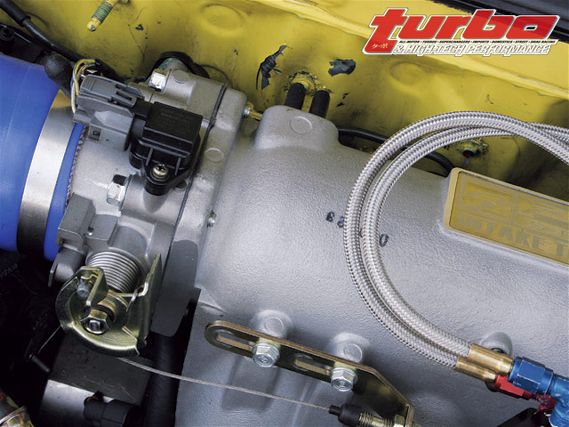 | Our H22A is mildly modified. Baseline tests included a 68mm throttle body, Skunk2 valvetrain and Stage 1 camshafts as well as a DC Sports header, AEM cold air intake and Skunk2 exhaust.
| Our H22A is mildly modified. Baseline tests included a 68mm throttle body, Skunk2 valvetrain and Stage 1 camshafts as well as a DC Sports header, AEM cold air intake and Skunk2 exhaust.
Similar to the microswitch, the NCM-2 activates nitrous oxide flow based on throttle position, but the NCM-2 does so digitally. This allows users to program throttle-based nitrous engagement values from inside their vehicle and change them whenever they want. The NCM-2 learns the engine's TPS characteristics the first time it's used and displays throttle angle readings through a series of LED lights on the controller's face.
The box also features a built-in time delay so nitrous activation can be postponed for up to five seconds from the time the desired throttle position is triggered. This is especially useful for front-wheel-drive vehicles looking for a bit of traction buildup prior to squeezing. It's easier on the drivetrain too, which means there's less chance in damaging axles, driveshafts or gearboxes. Nitrous activation, purge and throttle control changes are all made directly from the controller, eliminating any switches and toggles you may be accustomed to from the past. You won't miss them though. The NCM-2 also boasts a couple of important safety features. It disconnects nitrous engagement each time the vehicle's shut off and disregards nitrous activation at values below 55 percent throttle. An engine that's filled with nitrous oxide prior to start-up as well as low-rpm nitrous engagement are both popular culprits for those infamous engine block holes we mentioned earlier.
To throw Venovus' controller and solenoid driver through their paces, we looked to the H22A-swapped Honda Civic. The little hatchback's already traction limited so if we're going to fit nitrous oxide to it we've got to have a way to prolong activation. The only problem with installing a direct port nitrous oxide kit to the Prelude's H22A engine is finding a place to mount the foggers on the intake manifold. The manifold's exhaust gas recirculation ports make positioning the foggers up top impossible, which leaves two options: mount them underneath or switch to another manifold. Mounting the foggers and lines underneath the manifold wasn't an option here. We want to be able to keep tabs on the system and keep everything accessible in the event of a leak. We also want to be able to easily access the foggers for when, not if, we fit larger jets to the system. A stealth, street racer install isn't our goal here but rather something easy to work on and ultra reliable.
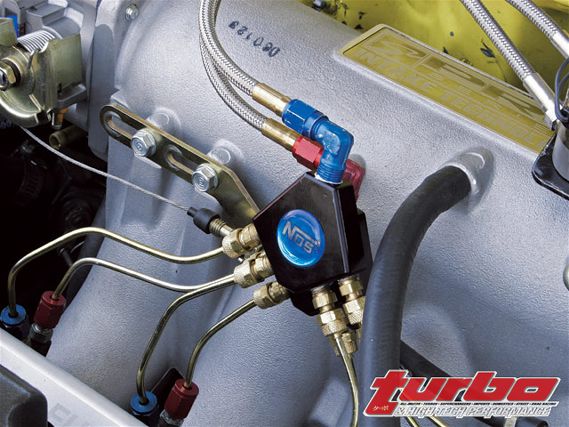 | There's plenty of room for any direct port nitrous oxide kit's foggers up top now. The Skunk2 Pro Series manifold also has built-in provisions for the throttle cable and idle air control valve and features a 66mm opening on the throttle body side.
| There's plenty of room for any direct port nitrous oxide kit's foggers up top now. The Skunk2 Pro Series manifold also has built-in provisions for the throttle cable and idle air control valve and features a 66mm opening on the throttle body side.
To solve our fogger dilemma we contacted Skunk2 for one of their Pro Series intake manifolds. The benefits of the Pro Series manifold are more than just allowing us to find a place to fit our nitrous foggers. The larger runners and plenum volume helped us pick up sizable torque and horsepower gains across the board thanks to some fine-tuning of our Hondata S100 by Do It Dyno's Carlos "Bubba" Ocegueda. We found moderate power gains after first installing the manifold, but it wasn't until Bubba massaged the air/fuel curve that we were able to net an impressive 24 additional horsepower out of the midrange. Keep in mind, this is before we even turned on the nitrous. We should also mention here that the Pro Series manifold is also paired with a set of Skunk2 Stage 1 camshafts that were already installed for our baseline tests and a 68mm throttle body. We also swapped our spark plugs for colder heat range NGK plugs to ensure a bit of nitrous safety. Prior to installing Skunk2's manifold, engine power was limited below the 7,500rpm range. The larger plenum volume is good for at least another 1,000 rpm or so as we picked up about 6 hp at the peak. We suspect power differences once the nitrous is activated would be much greater since the added plenum volume and runner diameters will allow for even better cylinder filling.
Despite conservative jetting, traction during nitrous activation is nonexistent. We expected as much. From about 4,500 rpm onward it's nothing but tire squeal. That's where the NCM-2 comes in. We were able to delay nitrous activation in 0.25-second increments to find that happy spot where our meats hook up and the car actually moves. Spinning in place is never fun.






